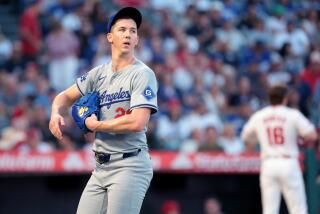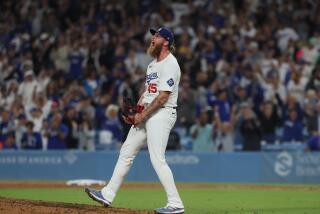Jones keeps taking hard shots
- Share via
It was the shot heard ‘round L.A., the hometown fans taking a shot at the hometown center fielder. The San Diego Padres cut Jim Edmonds on Friday, and the reaction among Dodgers fans on air and online was as prompt as it was predictable: If the Padres can get rid of their crummy center fielder, why can’t we?
This was not the welcome the Dodgers envisioned for Andruw Jones.
They needed home runs, and Jones hits 25 in a bad year. They coveted a defensive presence in center field, and Jones has won a Gold Glove 10 years running. They had millions of dollars to spare -- thank you, fans! -- and so they lavished upon him the highest annual salary in franchise history.
The cheers have yet to follow. The boos have been relentless. Jones strikes out, and he gets booed. Matt Kemp strikes out, and Jones gets booed. Brad Penny gets shelled, and Jones gets booed.
For his $18 million, Jones is hitting .170, with one home run. He strikes out once every three at-bats. In 27 at-bats with runners in scoring position, he has made 26 outs.
He has driven in four runs, the same as Chin-lung Hu, and Brandon Webb.
This is how bad it has gotten: Manager Joe Torre used Jones to pinch-hit in the ninth inning Wednesday, with the Dodgers losing, 12-0. That’s a spot for a scrub, not a five-time All-Star, but maybe Jones could get the hit that would free him from his misery.
Jones doubled, an ugly bloop that landed just beyond the first baseman, his second extra-base hit in 18 days.
“I just have to keep working,” Jones said. “It will pay off. It’s not like I never played the game before.
“You have to keep battling. When September gets here and you finish strong, no one will remember the first two weeks.”
Jason Schmidt couldn’t throw very hard last spring, and the Dodgers discovered his shoulder was a mess. Jones can’t hit very well this spring, but he says he’s fine.
He hit 51 home runs three years ago, 41 two years ago, 26 last year. In this post-Canseco era of drug testing, you have to ask about steroids, and Jones shakes his head no.
“Everybody that did it, you can see how it paid off,” he said. “They all got hurt. They’re on the disabled list, or they’re out of baseball.”
Steroids can make for a bigger and better player, he said, but at the risk of blowing out tendons and hamstrings unable to support that bigger player.
“To be that big wears the insides of your body out,” Jones said. “I’ve never been on the disabled list.”
The contract isn’t wearing on him, he said. The Atlanta Braves paid him $75 million over six years; the Dodgers signed him for $36 million over two.
“I made twice the money I’m making now in Atlanta,” he said. “It’s not about the money. I just go out there and play hard.
“All of a sudden, you have one bad year, and people say you lost it. These things happen.”
But what if he has lost it? It seems silly, since Jones just turned 31.
He says he’s still adjusting to living on the West Coast, Torre says he’s still adjusting to playing with a new team, and we’d feel better about either suggestion if Jones hadn’t performed so poorly last season.
He hit .222. The Dodgers bet that Jones simply had one bad year.
“I just don’t believe he can’t hit any more,” Torre said.
Two talent evaluators aren’t so sure. Neither one was authorized by his club to speak publicly about Jones.
“I don’t see anything that would make him better than a fourth outfielder,” an American League evaluator said.
His bat speed has slowed, the evaluators said, a trend that generally does not reverse itself unless an injury explains the decline. Of course, his bat would look quicker with a flurry of home runs.
In 2005-06, Jones ranked fifth in the National League in slugging percentage, at .553. In 2007-08, he ranks 80th, at .389.
He strikes out as never before, and he struggles even when he makes contact. In 2005-06, when Jones put a fastball in play, he hit .363, according to STATS LLC. In 2007-08, that average is .305.
“If I were the opposing team, I’d throw him nothing but fastballs until he proves he can hit them,” an NL evaluator said.
That evaluator said he clocked Jones -- while beating out an infield hit -- at 4.7 seconds to first base.
“That’s what a catcher runs,” he said.
And, although the Dodgers trumpet defense, the evaluators independently made the same observation about Jones: He used to play notoriously shallow, daring anyone to hit balls over his head, knowing he could race back and catch them. Now he plays deep, so balls drop in front of him.
Two statistical measures -- zone rating and range factor -- suggest Jones ranks as an average center fielder.
Jones weighed 210 pounds during his glory years with the Braves. He weighed 248 this spring, so perhaps the decline in speed and range can be reversed.
“I’m not saying he’s not overweight,” Torre said.
Kevin Towers, the general manager of the Padres, tried to interest Jones in a one-year contract before picking up Edmonds. He is the man who cut Edmonds, who was hitting .178 with one home run, but Towers said he saw no parallel to the Jones situation.
Edmonds is several years older than Jones, with a long history of injuries, Towers said, and he did not fit into the Padres’ plans beyond this year.
“I’ve seen Jones start slow before,” Towers said. “The tools are still there. He can still play a good center field. When all is said and done, I would think he’ll help the Dodgers.”
Jones can help the Dodgers by repeating what he did last year. They wouldn’t be thrilled with the .222, but they still need the pop. They rank among the bottom three in the league in home runs.
If the power outage is not temporary, however, the Dodgers might be better off with Kemp in center field and Juan Pierre in left.
Pierre has better speed, Jones a better arm. But, if you have to choose between two singles-hitting outfielders, you might as well play the one who can hit .300.
--
More to Read
Are you a true-blue fan?
Get our Dodgers Dugout newsletter for insights, news and much more.
You may occasionally receive promotional content from the Los Angeles Times.








